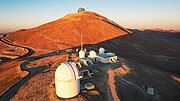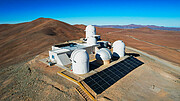Announcement
Rolf Chini Cerro Murphy Observatory inaugurated
28 November 2023
Today, in a celebration at Cerro Murphy in the Chilean Atacama Desert, the Nicolaus Copernicus Astronomical Center of the Polish Academy of Sciences (CAMK), along with the European Southern Observatory (ESO) and other entities, inaugurated the renewed Rolf Chini Cerro Murphy Observatory. Hosted within ESO’s Paranal Observatory, the Observatory has undergone a major rebuild since 2020 and is ready to begin scientific observations again, marking a new chapter in its history.
The Rolf Chini Cerro Murphy Observatory inauguration celebrates the beginning of scientific operations for three new optical telescopes, which will join existing facilities to explore how fast the Universe is expanding.
The Observatory is dedicated to the Araucaria Project, a collaboration between astronomers from Chile, the USA and Europe, focused on improving the calibration of the extragalactic distance scale, a combination of methods by which astronomers measure the distance of objects throughout the Universe. The data gathered at the Observatory will be important for determining precisely the expansion rate of the Universe.
Located in the high and dry Atacama Desert, the observing conditions are among the best in the world. As well as sharing pristine skies with other ESO telescopes — ESO’s Extremely Large Telescope (ELT) is under construction on the neighbouring Cerro Armazones, and Cerro Paranal, where ESO’s Very Large Telescope (VLT) is located, is just 20 kilometres away — the separate facilities will share resources such as fibre optic cables for internet and access roads.
In addition to the renewed scientific capability of the Observatory, the inauguration also marks a new era in its operation. In 2020, leadership was transferred from the Ruhr University Bochum (RUB) and the Catholic University of the North (UCN), who had jointly run it since 2005, to CAMK. Formerly called the Cerro Armazones Observatory, the new name honours Rolf Chini, a professor at RUB who is credited with the creation and development of the observatory, and Cerro Murphy, the hill it resides on.
The new optical telescopes include the 1.5-metre telescope Janusz Kałużny, for imaging and high resolution spectroscopy, as well as the 0.8-metre telescope Zbigniew "Zibi" Kołaczkowski and the 0.6-metre telescope Wojtek Krzemiński, both for imaging. In addition, a new 2.5-metre telescope, the largest Polish telescope to date, will be added to the Observatory, with the start of operations planned for 2025. From the Observatory’s previous operations are the 0.8-metre InfraRed Imaging System (IRIS), an infrared imager, and the 30-centimetre BMK10k, a robotic, wide-field camera operated by the Leibniz-Institute for Astrophysics in Potsdam.
To follow along with the celebrations, watch the inauguration on YouTube.
Links
Contacts
Bárbara Ferreira
ESO Media Manager
Garching bei München, Germany
Tel: +49 89 3200 6670
Email: press@eso.org
About the Announcement
| Id: | ann23020 |


